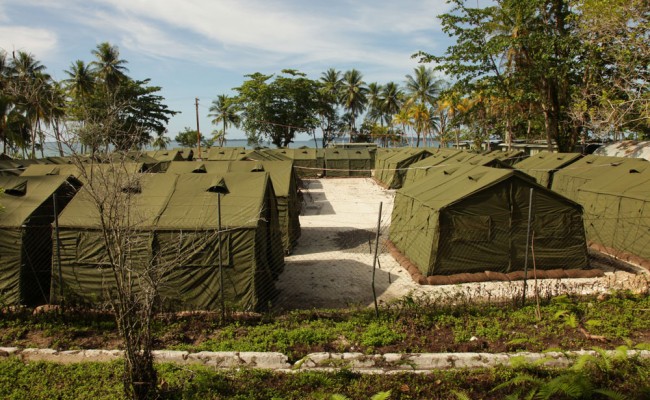In 2012, I set fire to one of my sculptures on the bank of the Yarra River, in Melbourne’s CBD. It was a sort of rapid response to the knowledge that multi-billion dollar company Transfield had just received a $24.5 million contract from the Labor government to provide refugee detention centre services and infrastructure on the island of Nauru. Crucially, Transfield has also been a major sponsor of the Biennale of Sydney, a high-profile internationally renowned art event, since 1973. Destroying the artwork in this fashion was an attempt to highlight that Transfield’s investment in arts and culture is paid for by the misery, anguish and isolation of refugees trapped within Australia’s racist system of ‘border protection’.
Sydney artist Jacquelene Drinkall staged a similar protest on the same day, and we also had the support of a small number of refugee activists and artists. We set-up a Facebook page to publicise the action, hoping to gain a bit of traction in terms of a longer lasting campaign against Transfield’s complicity in the detention of refugees. Unfortunately, the traction stopped, and it seemed Transfield was set to continue its glistening, golden handshakes while hobnobbing with art-world elites.
Jump to 2014: the relationship between Transfield and the Biennale of Sydney has had its shiny veil lifted, thanks to an open letter by Sydney-based arts educator, Matthew Kiem. The call to boycott the nineteenth Biennale of Sydney has gained significant support among arts workers, refugee activists, academics and art enthusiasts, both locally and from around the world. Kiem’s letter highlights Transfield’s attainment of further multi-million dollar grants from the current Liberal government so the company can expand its services from Nauru to Manus Island.
Recently, Manus Island was the site of immense suffering, yet Transfield mirrors the Australian government’s cold distancing from the situation. Therefore, a boycott of the biennale makes sense. We cannot allow a major art event to speak to the freedom of art while its largest donor actively opposes the rights of people – under international law – to seek refuge from war and poverty.
Since the open letter, arts workers have started a Facebook campaign called Boycott the 19th Biennale of Sydney, which has gained more than 1000 supporters. Liberate Tate, a group well-known for protesting London’s Tate Gallery relations with BP (the oil company known for its massive scale environmental destruction) has sent a letter of solidarity in support of the boycott. And while not entirely supportive of the boycott, twenty-eight of the artists set to exhibit have written a letter to the Biennale’s board of directors demanding they sever ties with Transfield.
Later today (Monday 24 February), there is a protest against the Biennale at the Australian Centre for Contemporary Art in Melbourne, which is apparently the venue for a Biennale promotional event.
Predictably, the Biennale’s board have responded with a mishmash of flighty words that lets Transfield off the hook. Some of it goes like this:
The Biennale’s ability to effectively contribute to the cessation of bi-partisan government policy is far from black and white.
In addition, the board of directors’ concern for art’s superiority over blatant human rights abuses reads:
The only certainty is that without our Founding Partner, the Biennale will no longer exist … The Biennale has long been a platform for artists to air their sometimes challenging but important views unfettered and we would like to explore this avenue of expression, rather than see the demise of an important community asset.
Personally, I’d have no concern if the Biennale faded out of existence. I don’t think anyone should be overly concerned about the festival’s fate when it’s people that are fading out of existence in the offshore detention centres at Nauru and Manus Island.
It is important to persist with the boycott for the length of the nineteenth Sydney Biennale (21 March–9 June), even if it means having to extend the campaign to the next one, set to take place in 2016. Because Transfield and the Biennale board of directors may not budge yet. But if they are consistently faced with pressure from a growing base of boycott supporters, they begin to contradict the sentiments of the audience they are trying to sell to. That is what’s at the heart of a boycott.
Moreover, through the targeting, isolation and interruption of the process of exchange, a bigger picture can be drawn, revealing the interconnectedness of government, big business and culture. Such information helps convert social justice campaigns, which are sometimes overwhelming or amorphous, into a movement with concrete objectives.
Goals can be achieved and won. Many examples have shown this throughout history, including the boycott, divestment and sanctions campaign against apartheid in South Africa, as well as the current BDS campaign against Israeli apartheid.






